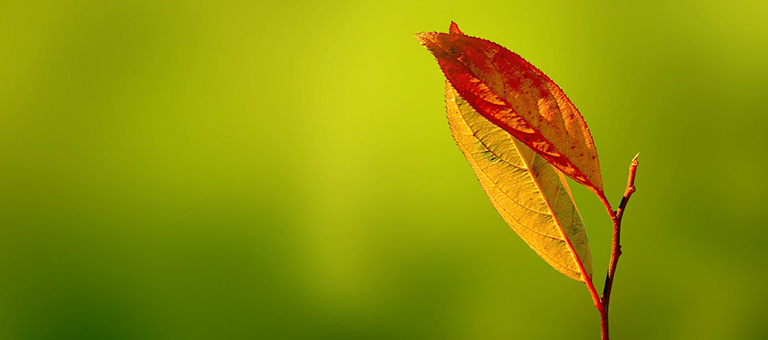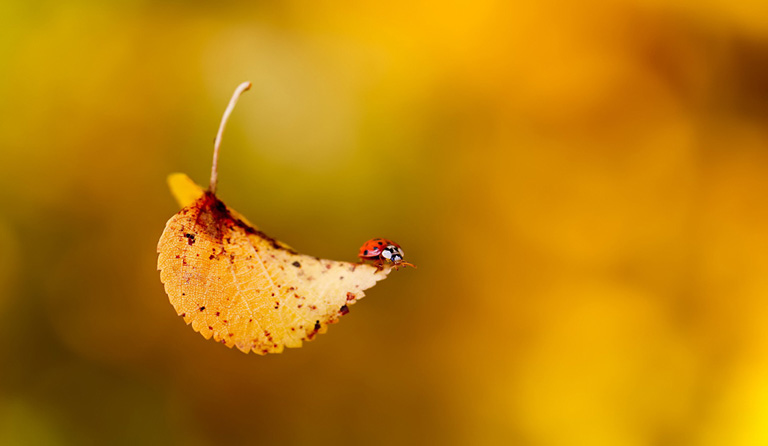Autumn Splendor

Sure leaves are pretty from afar but take some time to get real close. Nature is incredible, isn’t it?
Oh, and by-the-way, I have this incredible itch to flatten that dried leaf on top. But that’s just me.
Every autumn I marvel in the beauty of the fall colors. Whether I’m out for a morning run, raking and blowing leaves in the yard, or driving on county roads visiting some of my favorite customers, I just love this time of year. And I’m sure like you, just when the sun hits the trees at the right angle, we get a sense of nature’s grandeur, and know just how lucky we are to live and work in northeast Ohio. I remember back in grade school I learned about chlorophyll, but I thought I’d double check my knowledge, share with you and also give you a list of some great hiking trails in the area. Before the weather gets really chilly, and the leaves drop, do yourself a favor, get outside and enjoy. And send me your photos, and I’ll post them on a future blog for us all to see – top three will get a KHT prize in the mail. (special thanks to weather.com and US National Arboretum usna.usda.gov).
- The mixture and variety of purple, red, orange, yellow and light green is the result of chemical processes that take place in the trees as we change over from summer to fall to winter.
- During the spring and summer the leaves have served as factories where most of the foods necessary for the tree’s growth are manufactured. This food-making process takes place in the leaf in numerous cells containing chlorophyll, which gives the leaf its green color. This extraordinary chemical absorbs from sunlight the energy that is used in transforming carbon dioxide and water to carbohydrates, such as sugars and starch.
- Along with the green pigment are yellow to orange pigments, carotenes and xanthophyll pigments which, for example, give the orange color to a carrot. Most of the year these colors are masked by greater amounts of green coloring.
- But in the fall, because of changes in the length of daylight and changes in temperature, the leaves stop their food-making process. The chlorophyll breaks down, the green color disappears, and the yellow to orange colors become visible and give the leaves part of their fall splendor.
- At the same time other chemical changes may occur, which form additional colors through the development of red anthocyanin pigments. Some mixtures give rise to the reddish and purplish fall colors of trees such as dogwoods and sumacs, while others give the sugar maple its brilliant orange.
- The autumn foliage of some trees show only yellow colors. Others, like many oaks, display mostly browns. All these colors are due to the mixing of varying amounts of the chlorophyll residue and other pigments in the leaf during the fall season.
- As the fall colors appear, other changes are taking place. At the point where the stem of the leaf is attached to the tree, a special layer of cells develops and gradually severs the tissues that support the leaf. At the same time, the tree seals the cut, so that when the leaf is finally blown off by the wind or falls from its own weight, it leaves behind a leaf scar.
- The process that starts the cascade of events that result in fall color is actually a growth process. In late summer or early autumn, the days begin to get shorter, and nights are longer. Like most plants, deciduous trees and shrubs are rather sensitive to length of the dark period each day. When nights reach a threshold value and are long enough, the cells near the juncture of the leaf and the stem divide rapidly, but they do not expand. This abscission layer is a corky layer of cells that slowly begins to block transport of materials such as carbohydrates from the leaf to the branch. It also blocks the flow of minerals from the roots into the leaves. Because the starting time of the whole process is dependent on night length, fall colors appear at about the same time each year in a given location, whether temperatures are cooler or warmer than normal.
- In autumn, when the connection between the leaf and the rest of the plant begins to be
blocked off, the production of chlorophyll slows and then stops. In a relatively short time
period, the chlorophyll disappears completely. - Most of the broad-leaved trees in our area shed their leaves in the fall. However, the dead brown leaves of the oaks and a few other species may stay on the tree until growth starts again in the spring. In the South, where the winters are mild, some of the broad-leaved trees are evergreen; that is, the leaves stay on the trees during winter and keep their green color.
- Most of the conifers – pines, spruces, firs, hemlocks, cedars, etc. – are evergreen in both the North and South. The needle, or scale-like leaves remain green or greenish the year round, and individual leaves may stay on for two to four or more years.
- Temperature, light, and water supply have an influence on the degree and the duration of fall color. Low temperatures above freezing will favor anthocyanin formation producing bright reds in maples. However, early frost will weaken the brilliant red color. Rainy and/or overcast days tend to increase the intensity of fall colors. The best time to enjoy the autumn color would be on a clear, dry, and cool (not freezing) day.
Here are some great spots to hike and photograph the colors:
- Black River Reservation in Elyria has nearly 500,000 visitors each year. The paved Steel Mill Trail, about two miles long, crosses the Black River and French Creek. It also offers an array of stunning views of nature and the steel mill.
- Chapin Forest Reservation in Kirtland has views of a historic quarry. The Lucky Stone Loop Trail is a difficult 1.5-mile hike, but at the highest point hikers can see all the way downtown.
- Cleveland Metroparks’ Scenic Park Loop Trail is part of the Rocky River Reservation. The trail is 0.7 miles long and is mostly flat so even the most inexperienced hikers can enjoy the trail along the Rocky River.
- Gorge Metro Park in Summit County is a 1.8-mile course ranging from easy to rigorous hiking. The trail has access to the Mary Campbell Cave and many rock formations. There is also access to two waterfalls and fishing docks.
- Lake Erie Bluffs in Lake County. The Shoreline Trail goes along ¾ mile of protected shoreline, dotted with rocks, sand and driftwood and eagle sightings.
- Mentor Marsh State Nature Preserve, owned by the Cleveland Museum of Natural History, offers views of wetland plants and wildlife. The 1/3-mile Wake Robin Trail offers an up-close look from a boardwalk.
- Ohio and Erie Towpath Trail in Cuyahoga County is more than 20-miles long and boasts hiking, biking, running and walking trails. Bikers have the opportunity to use the Bike Aboard Program. They can start at any point in the trail and bike one way and ride back on the train for $3, runners and hikers pay $9.
- Princess Ledges Nature Preserve in Medina County is a good spot for seeing spring warblers, wildflowers, oak trees and tulip poplar trees. The moderate, mile-long Nature Trail leads to the half-mile Ledge Trail, which has views of the dramatic sandstone shoreline.
- Walter C. Best Wildlife Preserve is a 101-acre reservation in Geauga County. The Cattail Trail goes about 1 mile around the scenic Best Lake. Fishing platforms along the way allow hikers to take in waterfowl and other wildlife.
- Nelson-Kennedy Ledges State Park (Portage County) – Three miles of hiking trails featuring unusual rock formations with names like Indian Pass and Old Maid’s Kitchen. Best for experienced hikers and adults.
- Beaver Creek State Park (Columbiana County) – Sixteen miles of hiking trails and 23 miles of bridle trails that border on the gorge of Little Beaver Creek, a state wild and scenic river.
- Findley State Park (Lorain County) – Ten miles of hiking and mountain biking trails (including part of the Buckeye Trail) that run through portions of a scenic old-growth forest.
- Mohican State Park-Mohican Memorial State Forest (Ashland/Richland counties) – Thirty-seven miles of hiking trails, including some multiple-use trails, that slice rolling hills and the Clear Fork River Gorge, designated a National Natural Landmark.
- Quail Hollow State Park (Stark County) – Twelve miles of hiking trails, including a one-mile paved path, are a good place for beginning hikers. This is one of the most picturesque urban parks in Ohio.
- Fowler Woods State Nature Preserve (Richland County) – Three hiking trails meander through this 148-acre preserve, one of the oldest in the state. Some trees here are 100 to 200 years old.
- Blackhand Gorge State Nature Preserve (Licking County) – Six trails of varying lengths including a 4 mile bike trail, cut this 970-acre preserve which lies on the Licking River Gorge.






Leave a Reply
Want to join the discussion?Feel free to contribute!